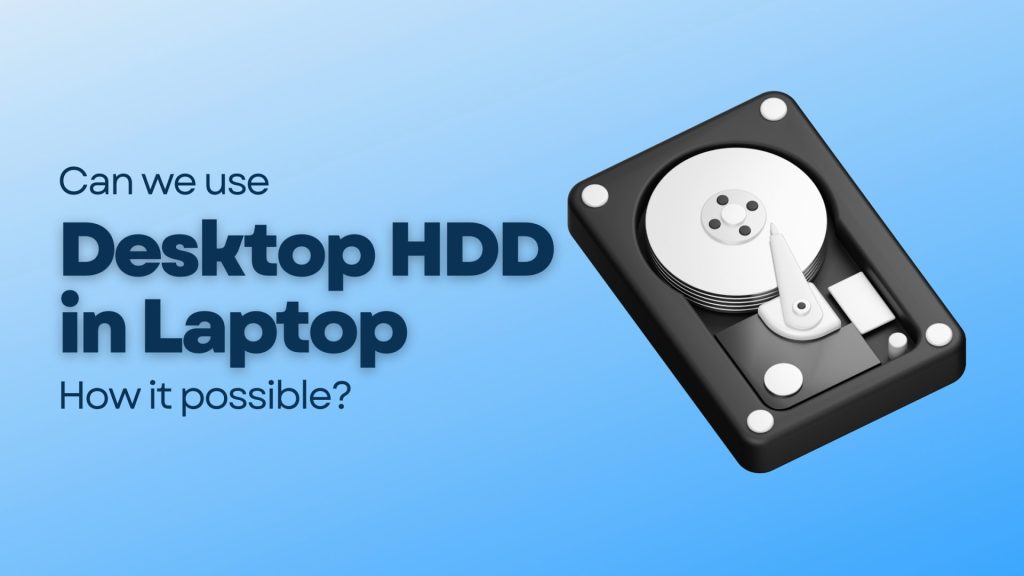Desktop HDDs typically use a 3.1-inch form factor, whereas laptop HDDs use a 2.1-inch form factor.
Consequently, while a laptop hard drive can be utilized in a desktop computer, the reverse is impossible due to the larger size of the desktop hard drive.
So Here’s a question worth a million dollars.
Let’s Explore it how can be possible for a desktop HDD to be used on a laptop or is it safe or not and its safety tips or more related queries.
Laptop HDD VS Desktop HDD
It’s important to note that laptop and desktop HDDs exhibit differences and similarities.
To better comprehend their functioning, let’s delve into some of these distinctions and similarities in more detail in the following paragraph.
1. Hard drive Range(Capacity): Typically, a laptop hard drive ranges from 500 GB to 1 TB, whereas a desktop HDD’s average capacity is 6.7 TB.
The number of platters within the HDD determines its capacity, with each platter able to store a specific amount of data.
Given their larger size, desktop HDDs often have more platters than laptop HDDs, leading to a higher storage capacity.
2. Speed(RPM): Typically, a laptop hard drive has an average speed of 5400 RPM, while a desktop HDD has an average speed of 7200 RPM.
This is because desktop HDDs are usually larger, more powerful, and have more space, allowing them to accommodate faster-spinning disks.
3. Performance: Given that desktop HDDs are more extensive, have more platters, and spin faster, it’s unsurprising that they tend to perform better than laptop HDDs.
4. Inch Factor(Size): The 2.5-inch form factor, due to its smaller size and lower power consumption, is typically utilized in laptops.
In contrast, the more prominent 3.5-inch form factor is commonly found in desktop computers as it can store more data and perform faster.
SATA protocol inch factor
The SATA (Serial ATA) protocol is a bus interface that hard drives and other devices use to connect to a computer.
It has become the standard interface in laptop and desktop computers, replacing the older PATA (Parallel ATA) interface.
SATA III is the most widely used version, with a data transfer speed of 6 Gbps.
Regarding size, there are two primary form factors for SATA hard drives: the 2.5-inch and 3.5-inch.
Laptops generally use the smaller 2.5-inch form factor The 2.5-inch form factor derives its name from the actual diameter of the spinning disks inside the hard drive.
While desktop computers utilize the more prominent 3.5-inch form factor which is faster or more powerful rather than 2.5 inches.
Is both Laptop and Desktop HDDs are same?
“NO” because, laptops use 2.5-inch diameter disks for their hard disk drives (HDDs), whereas desktop manufacturers typically opt for 3.5-inch disks.
Can we use Desktop HDD as an external drive?
“Yes, of course” To use your old drive as an external hard drive, you can connect it to your computer using a cable with a SATA end and a USB end.
Attach the SATA end to the old drive and the USB end to your computer, and you’ll be able to access and use the drive for storage as long as it remains connected to your system via USB.
Which HDD is faster Laptop & Computer?
Desktop HDD is faster than laptop HDD, and the reason is its size.
How I will know if HDD is comfortable with the laptop?
It’s important to note that with the help of adapters and brackets, HDDs of the wrong size can be compatible by modifying them to fit correctly.
Will external hard drives increase laptop speed?
By adding a second hard drive, you can see improvements in loading speeds, which may free up system resources and ultimately enhance the overall rate of your laptop.
Which form factor is compatible with a Laptop computer?
SSD Inch factor is compatible with both. The standard form factor for an SSD is 2.5 inches, which fits inside the drive bay of most laptop or desktop computers.

Does all HDD compatible with all laptops?
Generally speaking, USB-compatible drives are highly compatible with various computer systems.
While some drives are equipped with Thunderbolt ports, they typically also feature USB connectivity.
Why don’t prefer HDD on laptops?
Solid-state media is less prone to physical damage than HDDs and is therefore preferable.
HDDs consume more energy and generate more heat, which must be considered in the engineering process.
Laptop harddisk vs External harddisk
The primary distinction between internal and external hard drives lies in their installation.
Internal hard drives are situated inside the laptop body or tower, whereas external hard drives connect to the laptop via a USB or FireWire connection.
How to use the external drive as a primary drive in a laptop?
To use an external hard drive as a primary one, connect it to your laptop as you would with a typical internal hard drive.
In some cases, no adjustments are required to enable its internal operation.
Be sure that your laptop is powered off during the entire procedure.
Which one is a good Desktop & Laptop internal drive or a portable & external drive?
Even though portable drives can provide capacities of up to 4TB, they are intended for only a short time.
On the other hand, Desktop & laptop drives place a higher priority on longevity, security, and reliability over portability, making them more suitable for professional and large-scale applications.
The average lifespan of a Desktop
On average, your hard drive can be trusted for about three to five years.
This conclusion is supported by a notable study conducted by Backblaze, an online backup firm that analyzed the failure rates of 25,000 operational hard drives.
Why is HDD air sealed?
Hard drives are not entirely sealed but are designed to regulate airflow in and out.
Every hard drive features a ventilation hole equipped with a highly refined particulate filter inside the drive case.
This ventilation is essential to maintain pressure equilibrium as the industry undergoes heating and cooling cycles.
If a hard drive lacked proper ventilation, pressure differentials could fail the enclosure seals, leading to the infiltration of dust particles into the industry.
How to swap hard drives between laptops?
It is essential to carefully examine the form factor of both drives, as you may have a slimmer 7 mm SSD and a 9 mm thick HDD.
In such a scenario, even if both drives are 2.5″ SATA, the more comprehensive drive may not fit into the Toshiba.
To avoid any issues, you can obtain the model numbers of the movements from the OS device manager and cross-check them against the manufacturer’s specifications.
If the operating systems on the drives are still functional, consider using an external USB drive and an adapter to clone the drives.
This approach is not only faster but also requires less effort.
Does it possible 2 drive on the same computer?
Indeed, typically, one drive is designated as the “boot device” containing Windows and is used to initiate the computer startup process.
The other drive is assigned as the “D” drive or the following available letter and is utilized to store data files, programs, and additional information.
It is commonly advised to use one drive for the OS (Windows) and software programs and a second for storing data (music, pictures, documents, videos, etc.).
This strategy allows for the reformatting of the OS drive and reinstallation of the OS without losing any data files in the event of a virus infection.
Moreover, transferring the data drive to the new system will preserve all data files in the case of a new computer.
How to connect the desktop HDD to the laptop via a USB port?
1. You will require a specialized enclosure, which comes in various forms, including the 3.5-Inch IDE to USB 2.0 External Enclosure.
This enclosure is intended for use with a standard 3.5-inch hard drive possessing an IDE interface, allowing it to be connected to the laptop via the USB 2.0 port.
2. The 3.5 Inch IDE to USB 3.0 is identical in design and purpose to the box above, but it boasts an increased data transfer rate.
3. The USB 3.0 to SATA III Hard Drive Case is a portable rectangular enclosure larger than the hard drive.
It is designed to house the hard drive by opening the box and placing the industry inside before sealing it shut and connecting it to the laptop via a USB cable.
A power supply is also required for this enclosure.
Problem or Troubleshoot you will face or how to fix them
If your computer cannot detect the disk, you may need to take two steps to resolve the issue.
1. To start, check if you have drivers for your disk enclosure box.
While Windows typically installs drivers automatically, non-standard packages may require additional drivers, which can cause issues.
To do this, open Device Manager and check if drivers are available for your device.
Ensure that there are no yellow exclamation marks indicating missing or
outdated drivers.
2. Navigate to Disk Management in Windows by right-clicking the START button (applicable to Windows 10).
Check if the connected HDD is visible in Disk Management. Changing the drive letter and formatting is the most reasonable solution if it is visible.
Conclusion
Luckily, both desktop and laptop hard drives utilize the SATA interface.
All that is required is to connect the 2.5″ laptop hard drive using a SATA data cable and a SATA power cable, and you should be ready to use it without any issues.
